
Phineas Taylor Barnum was an American showman, businessman, and politician remembered for promoting celebrated hoaxes and founding with James Anthony Bailey the Ringling Bros. and Barnum & Bailey Circus. He was also an author, publisher, and philanthropist, although he said of himself: "I am a showman by profession ... and all the gilding shall make nothing else of me." According to Barnum's critics, his personal aim was "to put money in his own coffers". The adage "there's a sucker born every minute" has frequently been attributed to him, although no evidence exists that he had coined the phrase.

Dwight May Sabin was an American politician who served as U.S. Senator from Minnesota and in the Minnesota Legislature. He is known for the business ventures of Seymour, Sabin & Co. and the Northwestern Car Company, highly successful enterprises dependent on the highly profitable prison labor contracts he had negotiated with the Minnesota State Government in the 1870s. His election to federal office, in 1883, came following an infamous prolonged dead-lock in the Minnesota State Senate, during which incumbent Senator William Windom failed of re-election following "the worst campaign in the known history of the state."

Goshen is a town in Orange County, New York, United States. The population was 14,571 at the 2020 census. The town is named after the Biblical Land of Goshen. It contains a village also called Goshen, which is the county seat of Orange County. The town is centrally located in the county.

The Ringling Bros. and Barnum & Bailey Circus, also known as the Ringling Bros. Circus, Ringling Bros., the Barnum & Bailey Circus, Barnum & Bailey, or simply Ringling, is an American traveling circus company billed as The Greatest Show on Earth. It and its predecessor have run shows from 1871, with a hiatus from 2017 to 2023. They operate as Ringling Bros. and Barnum & Bailey. The circus started in 1919 when the Barnum & Bailey's Greatest Show on Earth, a circus created by P. T. Barnum and James Anthony Bailey, was merged with the Ringling Bros. World's Greatest Shows. The Ringling brothers purchased Barnum & Bailey Ltd. in 1907 following Bailey's death in 1906, but ran the circuses separately until they were merged in 1919.

Edwin Denison Morgan was the 21st governor of New York from 1859 to 1862 and served in the United States Senate from 1863 to 1869. He was the first and longest-serving chairman of the Republican National Committee. He was also a Union Army general during the American Civil War. Morgan was known for his progressive views on education, prison reform, and women's suffrage. He helped to found the Republican Party in New York and was a strong supporter of the Presidency of Abraham Lincoln.

Bayard Taylor was an American poet, literary critic, translator, travel author, and diplomat. As a poet, he was very popular, with a crowd of more than 4,000 attending a poetry reading once, which was a record that stood for 85 years. His travelogues were popular in both the United States and Great Britain. He served in diplomatic posts in Russia and Prussia.

Barnum Brown, commonly referred to as Mr. Bones, was an American paleontologist. Named after the circus showman P. T. Barnum, he discovered the first documented remains of Tyrannosaurus during a career that made him one of the most famous fossil hunters working from the late Victorian era into the early 20th century.

Moses Kimball was an American politician, museum curator and owner, and showman. Kimball was a business rival and close associate of P. T. Barnum and public-spirited citizen of Boston, Massachusetts who represented the city in the Massachusetts General Court for several non-consecutive terms from 1851 and 1877 and made several runs for mayor.
Joice Heth was an African-American woman who was exhibited by P.T. Barnum with the false claim that she was the 161-year-old nursing mammy of George Washington. Her exhibition under these claims, and her public autopsy, gained considerable notoriety.

Routh Goshen, born Arthur James Caley, was most commonly known as Colonel Routh Goshen or the Arabian Giant or the Palestine Giant. He was billed as the tallest man in the world at 7 ft 11 in (2.41 m) and 620 pounds (280 kg) but was most likely no more than 7 ft 5 in (2.26 m) and 400 pounds (180 kg). His true origins were kept secret from the public during his performance years in the United States and were obscured by the many apocryphal biographies that were created to publicize him. His actual origins came out slowly after his death. His birth name was Arthur James Caley and he was born on the Isle of Man in 1824. His fictional biographies said he was born in Jerusalem on May 5, 1837. After his retirement in the 1880s, he settled in Middlebush, New Jersey, and gained the nickname the Middlebush Giant.
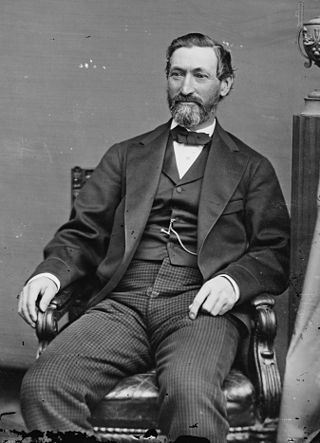
William Henry Barnum was an American politician, serving as a state representative, congressman, U.S. senator, and finally as chairman of the Democratic National Committee. He was also known as "Seven Mule Barnum".
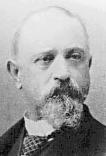
William Cameron Coup was a Wisconsin businessman who partnered with P. T. Barnum and Dan Castello in 1870 to form the "P. T. Barnum's Museum, Menagerie and Circus". Previously Barnum had a museum at a fixed location in New York City and the traveling circus allowed him to bring his curiosities to more paying customers. Coup's innovations were the circus train to transport the materials from town to town. He also came up with the concept of adding a second ring in 1872 and a third ring to the circus in 1881 to allow more people to view the events.
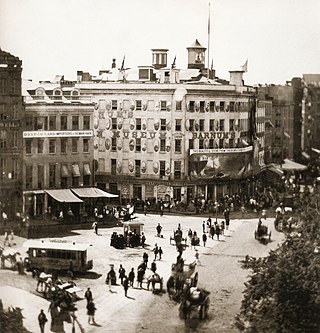
Barnum's American Museum was a dime museum located at the corner of Broadway, Park Row, and Ann Street in what is now the Financial District of Manhattan, New York City, from 1841 to 1865. The museum was owned by famous showman P. T. Barnum, who purchased Scudder's American Museum in 1841. The museum offered both strange and educational attractions and performances. Some were extremely reputable and historically or scientifically valuable, while others were less so.

A freak show is an exhibition of biological rarities, referred to in popular culture as "freaks of nature". Typical features would be physically unusual humans, such as those uncommonly large or small, those with intersex variations, those with extraordinary diseases and conditions, and others with performances expected to be shocking to viewers. Heavily tattooed or pierced people have sometimes been seen in freak shows, as have attention-getting physical performers such as fire-eating and sword-swallowing acts.

Madison Square Garden (1879–1890) was an arena in New York City at the northeast corner of East 26th Street and Madison Avenue in Manhattan. The first venue to use that name, it seated 10,000 spectators. It was replaced with a new building on the same site.

Tom Norman, born Thomas Noakes, was an English businessman, showman and the last exhibitor of Joseph Merrick who was otherwise known as the "Elephant Man". Among his later exhibits were a troupe of little people, a "Man in a Trance", "John Chambers, the armless Carpenter", and the "World's Ugliest Woman".
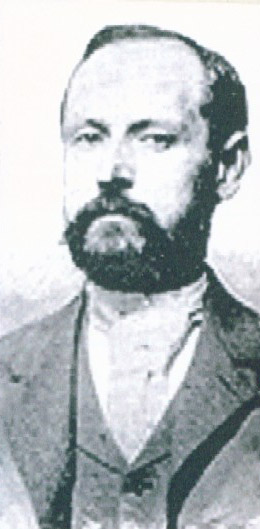
Hugh Bolton Jones was an American landscape painter. He grew up in Baltimore, Maryland, where he received his early training as an artist. While studying in New York he was strongly influenced by Frederic Edwin Church of the Hudson River School. After spending four years in Europe he settled in New York in 1881, where he shared a studio with his brother Francis Coates Jones for the rest of his long life. He was celebrated for his realistic depictions of calm rural scenes of the eastern United States at different times of the year, usually empty of people. He won prizes in several major exhibitions in the US and France. His paintings are held in public collections such as the Metropolitan Museum of Art and the Smithsonian Institution.
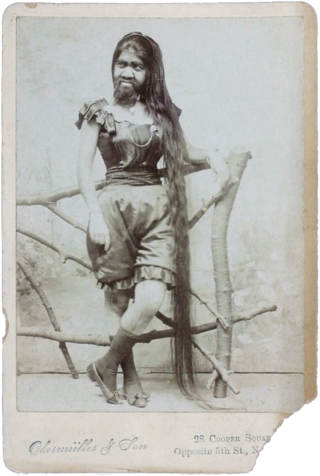
Krao Farini was an American sideshow performer who was born with hypertrichosis and took part in 19th-century exhibition tours in North America and Europe. She was adopted by William Leonard Hunt, also known as Guillermo Antonio Farini, who exploited her appearance. Throughout her life she was falsely advertised as a primitive human and billed as the missing link between humans and apes.
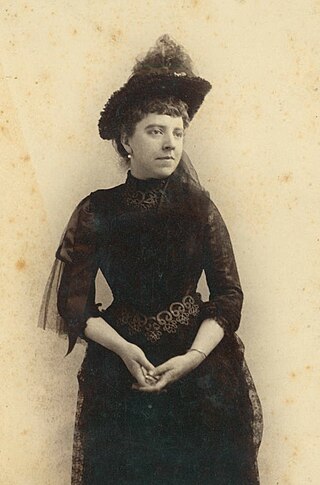
Nancy Fish Barnum Callias D'Orengiani, Baroness was an English socialite, daughter of a successful cotton miller and the second wife of P. T. Barnum, 40 years her senior. After the death of Barnum's first wife in 1873, they married the following year in both London and New York City. After his death in 1891, he left her a large annuity.
Willis Addison Reeve was an American dentist and politician from New York.


















